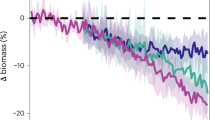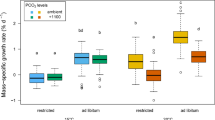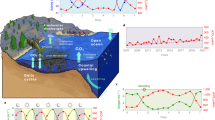Abstract
Ocean acidification—the decrease in seawater pH due to rising CO2 concentrations—has been shown to lower survival in early life stages of fish and, as a consequence, the recruitment of populations including commercially important species. To date, ocean-acidification studies with fish larvae have focused on the direct physiological impacts of elevated CO2, but largely ignored the potential effects of ocean acidification on food web interactions. In an in situ mesocosm study on Atlantic herring (Clupea harengus) larvae as top predators in a pelagic food web, we account for indirect CO2 effects on larval survival mediated by changes in food availability. The community was exposed to projected end-of-the-century CO2 conditions (~760 µatm pCO2) over a period of 113 days. In contrast with laboratory studies that reported a decrease in fish survival, the survival of the herring larvae in situ was significantly enhanced by 19 ± 2%. Analysis of the plankton community dynamics suggested that the herring larvae benefitted from a CO2-stimulated increase in primary production. Such indirect effects may counteract the possible direct negative effects of ocean acidification on the survival of fish early life stages. These findings emphasize the need to assess the food web effects of ocean acidification on fish larvae before we can predict even the sign of change in fish recruitment in a high-CO2 ocean.
This is a preview of subscription content, access via your institution
Access options
Access Nature and 54 other Nature Portfolio journals
Get Nature+, our best-value online-access subscription
$29.99 / 30 days
cancel any time
Subscribe to this journal
Receive 12 digital issues and online access to articles
$119.00 per year
only $9.92 per issue
Buy this article
- Purchase on Springer Link
- Instant access to full article PDF
Prices may be subject to local taxes which are calculated during checkout



Similar content being viewed by others
References
Haigh, R., Ianson, D., Holt, C. A., Neate, H. E. & Edwards, A. M. Effects of ocean acidification on temperate coastal marine ecosystems and fisheries in the northeast Pacific. PLoS ONE 10, e0117533 (2015).
Houde, E. D. Emerging from Hjort’s shadow. J. Northwest Atl. Fish. Sci. 41, 53–70 (2008).
Baumann, H., Talmage, S. C. & Gobler, C. J. Reduced early life growth and survival in a fish in direct response to increased carbon dioxide. Nat. Clim. Change 2, 38–41 (2011).
Munday, P. L. et al. Effects of elevated CO2 on early life history development of the yellowtail kingfish. ICES J. Mar. Sci. 73, 641–649 (2015).
Stiasny, M. H. et al. Ocean acidification effects on Atlantic cod larval survival and recruitment to the fished population. PLoS ONE 11, e0155448 (2016).
Nagelkerken, I., Russell, B. D., Gillanders, B. M. & Connell, S. D. Ocean acidification alters fish populations indirectly through habitat modification. Nat. Clim. Change 6, 89–95 (2015).
Goldenberg, S. U., Nagelkerken, I., Ferreira, C. M., Ullah, H. & Connell, S. D. Boosted food web productivity through ocean acidification collapses under warming. Glob. Change Biol. 23, 4177–4184 (2017).
Schulz, K. G. et al. Phytoplankton blooms at increasing levels of atmospheric carbon dioxide: experimental evidence for negative effects on prymnesiophytes and positive on small picoeukaryotes. Front. Mar. Sci. 4, 64 (2017).
Nagelkerken, I. & Connell, S. D. Global alteration of ocean ecosystem functioning due to increasing human CO2 emissions. Proc. Natl Acad. Sci. USA 112, 13272–13277 (2015).
Bach, L. T. T. et al. Influence of ocean acidification on a natural winter-to-summer plankton succession: first insights from a long-term mesocosm study draw attention to periods of low nutrient concentrations. PLoS ONE 11, e0159068 (2016).
IPCC: Summary for Policymakers. In Climate Change 2013: The Physical Science Basis (eds Stocker, T. F. et al.) (Cambridge Univ. Press, Cambridge, 2013).
Sswat, M., Boxhammer, T., Jutfelt, F., Clemmesen, C. & Riebesell, U. Performance of Herring Larvae in a Simulated Future Ocean Food Web, Using the ‘Kiel Off-Shore Mesocosms for Future Ocean Simulations’ (GEOMAR, 2016); https://doi.org/10.3289/KOSMOS_HERRING_SWEDEN_2013
Algueró-Muñiz, M. et al. KOSMOS 2013 Gullmar Fjord Long-Term Mesocosm Study: Mesozooplankton Abundance (PANGAEA, 2017); https://doi.pangaea.de/10.1594/PANGAEA.871233
Paulsen, M. et al. Nutritional situation for larval Atlantic herring (Clupea harengus L.) in two nursery areas in the western Baltic Sea. ICES J. Mar. Sci. 71, 991–1000 (2013).
Cushing, D. H. Plankton production and year-class strength in fish populations: an update of the match/mismatch hypothesis. Adv. Mar. Biol. 26, 249–293 (1990).
Harrell, F. E. Regression Modeling Strategies: With Applications to Linear Models, Logistic Regression, and Survival Analysis 465–507 (Springer, New York, 2001).
Franke, A. & Clemmesen, C. Effect of ocean acidification on early life stages of Atlantic herring (Clupea harengus L.). Biogeosciences 8, 3697–3707 (2011).
Frommel, A. Y. et al. Organ damage in Atlantic herring larvae as a result of ocean acidification. Ecol. Appl. 24, 1131–1143 (2014).
Maneja, R. et al. The swimming kinematics and foraging behavior of larval Atlantic herring, Clupea harengus L., are resilient to elevated pCO2. J. Exp. Mar. Biol. Ecol. 466, 42–48 (2015).
Maneja, R. H. et al. The proteome of Atlantic herring (Clupea harengus L.) larvae is resistant to elevated pCO2. Mar. Pollut. Bull. 86, 154–160 (2014).
Sswat, M., Stiasny, M. H., Jutfelt, F., Riebesell, U. & Clemmesen, C. Growth performance and survival of larval Atlantic herring, under the combined effects of elevated temperatures and CO2. PLoS ONE 13, e0191947 (2018).
Eberlein, T. et al. Effects of ocean acidification on primary production in a coastal North Sea phytoplankton community. PLoS ONE 12, e0172594 (2017).
Algueró-Muñiz, M. et al. Ocean acidification effects on mesozooplankton community development: results from a long-term mesocosm experiment. PLoS ONE 12, e0175851 (2017).
Taucher, J. et al. Influence of ocean acidification on plankton community structure during a winter-to-summer succession: an imaging approach indicates that copepods can benefit from elevated CO2 via indirect food web effects. PLoS ONE 12, e0169737 (2017).
Denis, J. et al. Feeding strategy of Downs herring larvae (Clupea harengus L.) in the English Channel and North Sea. J. Sea Res. 115, 33–46 (2016).
Horn, H. G. et al. Low CO2 sensitivity of microzooplankton communities in the Gullmar Fjord, Skagerrak: evidence from a long-term mesocosm study. PLoS ONE 11, e0165800 (2016).
Rossoll, D. et al. Ocean acidification-induced food quality deterioration constrains trophic transfer. PLoS ONE 7, e34737 (2012).
Checkley, D. M. Selective feeding by Atlantic herring (Clupea harengus) larvae on zooplankton in natural assemblages. Mar. Ecol. Prog. Ser. 9, 245–253 (1982).
Thomsen, J., Casties, I., Pansch, C., Körtzinger, A. & Melzner, F. Food availability outweighs ocean acidification effects in juvenile Mytilus edulis: laboratory and field experiments. Glob. Change Biol. 19, 1017–1027 (2013).
Bach, L. T., Alvarez-Fernandez, S., Hornick, T., Stuhr, A. & Riebesell, U. Simulated ocean acidification reveals winners and losers in coastal phytoplankton. PLoS ONE 12, e0188198 (2017).
Frommel, A. Y. et al. Severe tissue damage in Atlantic cod larvae under increasing ocean acidification. Nat. Clim. Change 2, 42–46 (2011).
Pimentel, M. S. et al. Defective skeletogenesis and oversized otoliths in fish early stages in a changing ocean. J. Exp. Biol. 217, 2062–2070 (2014).
Bignami, S., Enochs, I. C., Manzello, D. P., Sponaugle, S. & Cowen, R. K. Ocean acidification alters the otoliths of a pantropical fish species with implications for sensory function. Proc. Natl Acad. Sci. USA 110, 7366–7370 (2013).
Nagelkerken, I. et al Species interactions drive fish biodiversity loss in a high-CO2 world. Curr. Biol. 27, 2177–2184.e4 (2017).
Riebesell, U. et al. Technical note: a mobile sea-going mesocosm system—new opportunities for ocean change research. Biogeosciences 2, 1835–1847 (2013).
Boxhammer, T., Bach, L. T., Czerny, J. & Riebesell, U. Technical note: sampling and processing of mesocosm sediment trap material for quantitative biogeochemical analysis. Biogeosciences 13, 2849–2858 (2016).
Purcell, J. E. & Grover, J. J. Predation and food limitation as causes of mortality in larval herring at a spawning ground in British Columbia. Mar. Ecol. Prog. Ser. 59, 55–61 (1990).
Gorsky, G. et al. Digital zooplankton image analysis using the ZooScan integrated system. J. Plankton Res. 32, 285–303 (2010).
Hufnagl, M. & Peck, M. A. Physiological individual-based modelling of larval Atlantic herring (Clupea harengus) foraging and growth: insights on climate-driven life-history scheduling. ICES J. Mar. Sci. 68, 1170–1188 (2011).
Acknowledgements
We thank the Sven Lovén Centre for Marine Sciences, Kristineberg for providing the facilities to conduct this experiment. We acknowledge Yngve Elling Nicolaisen and the Marine Biological Station Drøbak for help obtaining the fish. We are grateful to the members of the ‘KOSMOS team’ for their enduring efforts to conduct this experiment. We are also thankful for the support of F. Dahlke and D. Storch, who provided us with the specifically designed ‘egg cages’. We thank the captain and crew of RV ALKOR for help with transporting and setting up the mesocosms (cruises AL406 and AL420). We acknowledge R. Erven, S. Schorr and D. Unverricht for designing the illustrations. The study was jointly funded by the Association of European Marine Biological Laboratories (http://www.assemblemarine.org; ASSEMBLE grant number 227799 to C.C. and M.S.), Swedish Academy of Sciences (to M.A.-M.) and German Federal Ministry of Education and Research (FKZ 03F06550) in the framework of BIOACID II (http://www.bioacid.de), and by the Leibniz Prize 2012 of the German Research Foundation (awarded to U.R.).
Author information
Authors and Affiliations
Contributions
M.S., U.R. and C.C. designed the experiment. M.S., M.H.S., F.J., L.T.B., M.A.-M., U.R. and C.C. performed the experiment. M.S. performed the survival analysis. M.A.-M. performed the zooplankton analysis. J.T. performed the particle analysis. L.T.B. performed the chlorophyll a analysis. M.S. and C.C. analysed the data. M.S., C.C. and U.R. wrote the paper. All authors discussed the results and implications, and commented on the manuscript at all stages.
Corresponding author
Ethics declarations
Competing interests
The authors declare no competing interests.
Additional information
Publisher’s note: Springer Nature remains neutral with regard to jurisdictional claims in published maps and institutional affiliations.
Supplementary information
Supplementary Information
Supplementary Figures 1–2; Supplementary Table 1
Rights and permissions
About this article
Cite this article
Sswat, M., Stiasny, M.H., Taucher, J. et al. Food web changes under ocean acidification promote herring larvae survival. Nat Ecol Evol 2, 836–840 (2018). https://doi.org/10.1038/s41559-018-0514-6
Received:
Accepted:
Published:
Issue Date:
DOI: https://doi.org/10.1038/s41559-018-0514-6
This article is cited by
-
Herbicide leakage into seawater impacts primary productivity and zooplankton globally
Nature Communications (2024)
-
Caught in the middle: bottom-up and top-down processes impacting recruitment in a small pelagic fish
Reviews in Fish Biology and Fisheries (2022)
-
Changing carbon-to-nitrogen ratios of organic-matter export under ocean acidification
Nature Climate Change (2021)
-
Food availability modulates the combined effects of ocean acidification and warming on fish growth
Scientific Reports (2020)
-
Impacts of ocean acidification under multiple stressors on typical organisms and ecological processes
Marine Life Science & Technology (2020)



